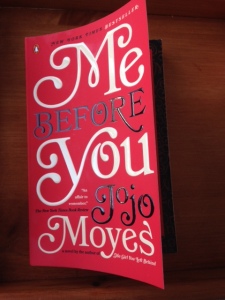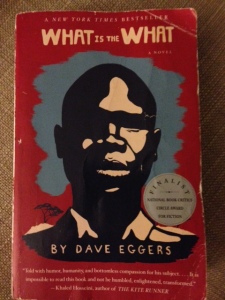I realized as I wiped the tears from my eyes at the end of “Me Before You” by Jojo Moyes, that I have read a few books lately that dealt with some really tough subjects. However, they all illicited different reactions from me because of the way the writer deals with the subject of suffering. And yet, despite their differences in dealing with suffering, I would rate all of these books the same: a solid 4.5/5 bacon strips. They all had a storyline that kept me turning the pages and characters that kept me intrigued.
 Let’s start with the runny account of suffering first. I picked up “Me Before You” by Jojo Moyes because it came highly recommended by a blog I read (thanks Meg!). I was feeling the need after reading some of these harder books below to spoon into something more light-hearted. This book is about Will, a quadrapeligic who is contemplating suicide, and his recently-hired caregiver, Louisa. Although this book has many romance novel clichés (which is what made me reduce it by half a bacon strip), the characters retain their flaws which endeared me to both of them because they resembled personalities I know. The plot depth comes from its exploration of the physical and mental suffering that Will faces as a quadripeligic. The book also looks at the right to die concept but from a very personal standpoint. It is this heartfelt look at the suffering faced by Will and the struggle experienced by his loved ones, that left me gulping with sobs at the end of the book. This was definitely a very soft-hearted, runny look at Suffering, and I enjoyed it very much!
Let’s start with the runny account of suffering first. I picked up “Me Before You” by Jojo Moyes because it came highly recommended by a blog I read (thanks Meg!). I was feeling the need after reading some of these harder books below to spoon into something more light-hearted. This book is about Will, a quadrapeligic who is contemplating suicide, and his recently-hired caregiver, Louisa. Although this book has many romance novel clichés (which is what made me reduce it by half a bacon strip), the characters retain their flaws which endeared me to both of them because they resembled personalities I know. The plot depth comes from its exploration of the physical and mental suffering that Will faces as a quadripeligic. The book also looks at the right to die concept but from a very personal standpoint. It is this heartfelt look at the suffering faced by Will and the struggle experienced by his loved ones, that left me gulping with sobs at the end of the book. This was definitely a very soft-hearted, runny look at Suffering, and I enjoyed it very much!
 “What is the What” by Dave Eggers retains this heartfelt look at suffering but creates some distance from the subject by writing in the first person protagonist. The distance (and what I loved about the writing style of this novel) is created by the protagonist, Valentino Achak Deng, recounting his childhood story (as a Lost Boy of the Sudanese Civil War) to people he encounters in his current life. For example, when he is waiting at the hospital to see a doctor, he mentally tells Julian, the receptionist, the story of his time at the refugee camp in Ethiopia. This storytelling dialogue method of telling the protagonist’s childhood is powerful because Valentino appeals to the emotions of his imaginary listeners through his heartbreaking story; but, he distances himself from the emotions of those experiences by clearly placing them in his past. The constant hardship he faces in his present life in the US (burgled, beaten, ignored) again shows the soft interior of suffering as he relates his present emotional distress. The tragedies that Valentino experiences in the US made me so frustrated at some points because I felt like it was time for life to cut him a break and this was supposed to be where he finds peace and stability. But that’s not real life and this novel is part memoir of the real Valentino’s life, so all of these heart-wrenching experiences did happen. Yet through his difficulties in the present and from his challenges faced in childhood, Valentino continues onward. The book ends on a postive note when he expresses gratitude for life and new possibilities, and shows how suffering does not always crack the shell of the sufferer.
“What is the What” by Dave Eggers retains this heartfelt look at suffering but creates some distance from the subject by writing in the first person protagonist. The distance (and what I loved about the writing style of this novel) is created by the protagonist, Valentino Achak Deng, recounting his childhood story (as a Lost Boy of the Sudanese Civil War) to people he encounters in his current life. For example, when he is waiting at the hospital to see a doctor, he mentally tells Julian, the receptionist, the story of his time at the refugee camp in Ethiopia. This storytelling dialogue method of telling the protagonist’s childhood is powerful because Valentino appeals to the emotions of his imaginary listeners through his heartbreaking story; but, he distances himself from the emotions of those experiences by clearly placing them in his past. The constant hardship he faces in his present life in the US (burgled, beaten, ignored) again shows the soft interior of suffering as he relates his present emotional distress. The tragedies that Valentino experiences in the US made me so frustrated at some points because I felt like it was time for life to cut him a break and this was supposed to be where he finds peace and stability. But that’s not real life and this novel is part memoir of the real Valentino’s life, so all of these heart-wrenching experiences did happen. Yet through his difficulties in the present and from his challenges faced in childhood, Valentino continues onward. The book ends on a postive note when he expresses gratitude for life and new possibilities, and shows how suffering does not always crack the shell of the sufferer.
 “She’s Come Undone” by Wally Lamb is written from the first person perspective about Dolores Price and the series of crises she goes through from age 10 to late 30s (parent’s divorce, rape, eating disorder, abortion, marriage ending in heartbreak). Seriously, this girl comes way undone emotionally and experiences one travesity after the next. Normally this would increase my connection to the suffering in a character, but she has a kind of hardness to her character….a certain stubbornness to ignore her suffering by refusing to seek means of healing. She lets her suffering build this protective shell around her as she continues to harden herself emotionally, or so she thinks. One of the things I really enjoyed about this novel was her imperfection and how even after she “recovers” in some ways, it still takes many more experiences for her to truly seek full healing from the tragedies in her life. And despite her hardness in the face of suffering, I kept reading because I wanted to see how she was going to live her life and I was rooting that she would find some softness and healing.
“She’s Come Undone” by Wally Lamb is written from the first person perspective about Dolores Price and the series of crises she goes through from age 10 to late 30s (parent’s divorce, rape, eating disorder, abortion, marriage ending in heartbreak). Seriously, this girl comes way undone emotionally and experiences one travesity after the next. Normally this would increase my connection to the suffering in a character, but she has a kind of hardness to her character….a certain stubbornness to ignore her suffering by refusing to seek means of healing. She lets her suffering build this protective shell around her as she continues to harden herself emotionally, or so she thinks. One of the things I really enjoyed about this novel was her imperfection and how even after she “recovers” in some ways, it still takes many more experiences for her to truly seek full healing from the tragedies in her life. And despite her hardness in the face of suffering, I kept reading because I wanted to see how she was going to live her life and I was rooting that she would find some softness and healing.
 Lastly, “Angela’s Ashes” by Frank McCourt is a memoir about Frank’s childhood first in America and returning to Ireland. His memoir is filled with events of suffering, yet no matter how many times life cracked his shell, Frank remains intact and whole. The large reason for this hard resiliency towards tragedy is that the narrator is a child for most of the book, so the deaths of siblings, the desperation of poverty, the betrayal of a drunk father, and the constant illnesses become more of a backdrop for the life of Frank. A sibling dies and Frank recalls the death in a few pages focussing on the food they ate and the people who visited. Frank is too young to really feel the effects of grief or understand the seriousness of his hospital stays, so he doesn’t emotional connect to the suffering going on around him. Through each tragic event, Frank continues onward with his life. Even when he grieves for the death of his teenage lover, it is quite short-lived and his sense of loss is replaced by his drive to start a new life away from Ireland. McCourt doesn’t shirk away from the tragic events in his life, but he is also doesn’t create an emotional reaction in the reader. He shows that one can grow up in the toughest of circumstances without falling apart in the face of suffering, and continue to dream and embrace the good things life does offer.
Lastly, “Angela’s Ashes” by Frank McCourt is a memoir about Frank’s childhood first in America and returning to Ireland. His memoir is filled with events of suffering, yet no matter how many times life cracked his shell, Frank remains intact and whole. The large reason for this hard resiliency towards tragedy is that the narrator is a child for most of the book, so the deaths of siblings, the desperation of poverty, the betrayal of a drunk father, and the constant illnesses become more of a backdrop for the life of Frank. A sibling dies and Frank recalls the death in a few pages focussing on the food they ate and the people who visited. Frank is too young to really feel the effects of grief or understand the seriousness of his hospital stays, so he doesn’t emotional connect to the suffering going on around him. Through each tragic event, Frank continues onward with his life. Even when he grieves for the death of his teenage lover, it is quite short-lived and his sense of loss is replaced by his drive to start a new life away from Ireland. McCourt doesn’t shirk away from the tragic events in his life, but he is also doesn’t create an emotional reaction in the reader. He shows that one can grow up in the toughest of circumstances without falling apart in the face of suffering, and continue to dream and embrace the good things life does offer.
*Special thanks to Janel for introducing me to the Wally Lamb novel and the Dave Eggers book. I can see why you hold these writers and these stories so dear!


